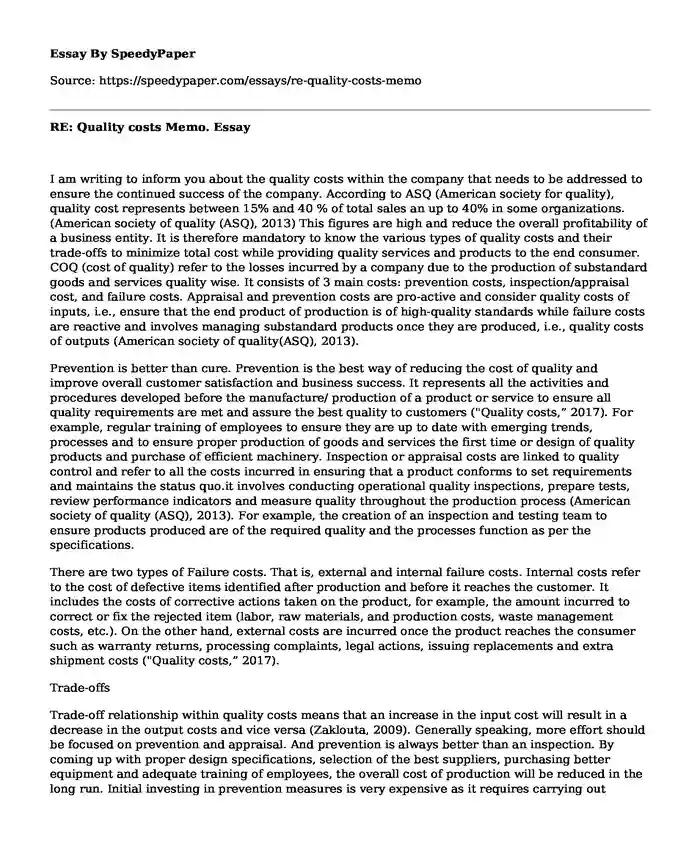
| Type of paper: | Essay |
| Categories: | Psychology Students Business |
| Pages: | 3 |
| Wordcount: | 789 words |
I am writing to inform you about the quality costs within the company that needs to be addressed to ensure the continued success of the company. According to ASQ (American society for quality), quality cost represents between 15% and 40 % of total sales an up to 40% in some organizations. (American society of quality (ASQ), 2013) This figures are high and reduce the overall profitability of a business entity. It is therefore mandatory to know the various types of quality costs and their trade-offs to minimize total cost while providing quality services and products to the end consumer. COQ (cost of quality) refer to the losses incurred by a company due to the production of substandard goods and services quality wise. It consists of 3 main costs: prevention costs, inspection/appraisal cost, and failure costs. Appraisal and prevention costs are pro-active and consider quality costs of inputs, i.e., ensure that the end product of production is of high-quality standards while failure costs are reactive and involves managing substandard products once they are produced, i.e., quality costs of outputs (American society of quality(ASQ), 2013).
Prevention is better than cure. Prevention is the best way of reducing the cost of quality and improve overall customer satisfaction and business success. It represents all the activities and procedures developed before the manufacture/ production of a product or service to ensure all quality requirements are met and assure the best quality to customers ("Quality costs," 2017). For example, regular training of employees to ensure they are up to date with emerging trends, processes and to ensure proper production of goods and services the first time or design of quality products and purchase of efficient machinery. Inspection or appraisal costs are linked to quality control and refer to all the costs incurred in ensuring that a product conforms to set requirements and maintains the status quo.it involves conducting operational quality inspections, prepare tests, review performance indicators and measure quality throughout the production process (American society of quality (ASQ), 2013). For example, the creation of an inspection and testing team to ensure products produced are of the required quality and the processes function as per the specifications.
There are two types of Failure costs. That is, external and internal failure costs. Internal costs refer to the cost of defective items identified after production and before it reaches the customer. It includes the costs of corrective actions taken on the product, for example, the amount incurred to correct or fix the rejected item (labor, raw materials, and production costs, waste management costs, etc.). On the other hand, external costs are incurred once the product reaches the consumer such as warranty returns, processing complaints, legal actions, issuing replacements and extra shipment costs ("Quality costs," 2017).
Trade-offs
Trade-off relationship within quality costs means that an increase in the input cost will result in a decrease in the output costs and vice versa (Zaklouta, 2009). Generally speaking, more effort should be focused on prevention and appraisal. And prevention is always better than an inspection. By coming up with proper design specifications, selection of the best suppliers, purchasing better equipment and adequate training of employees, the overall cost of production will be reduced in the long run. Initial investing in prevention measures is very expensive as it requires carrying out multiple activities at once and requires some time before the benefits can be realized.
Naturally, it is difficult to entirely prevent some issues as there will always be variability in the product either due to machinery used of capabilities of individual workers. Therefore, inspection is vital. It is essential to conduct to ensure that the process is within the control limits and that the products are within the desired range. Furthermore, an appraisal helps in coming up with corrective actions to streamline the process, improve efficiency, and reduce overall failure costs. Internal failure costs are preferable to external costs but are both generally expensive as compared to prevention and inspection costs. Finding defective products at the end of production indicates poor processing, poor quality control, and inadequate preventive measures. External failure may lead to damaging of brand image, class action suits, severe damage mitigation costs and poor relationship with customers and suppliers.
For the success of the business finding the perfect balance between the trade-offs or alternatively investing more on input costs will ultimately reduce output cost, increase brand recognition, and improve the relationship with customers and suppliers and the eventual success of the organization.
References
American society of quality (ASQ). (2013). Cost of Quality (COQ). Retrieved from https://asq.org/quality-resources/cost-of-quality
Quality costs: prevention, appraisal, internal and external failure costs. (2017, April 17). Retrieved from https://www.accountingformanagement.org/costs-of-quality-or-quality-costs/
Zaklouta, H. (2009). Cost of quality tradeoffs in the manufacturing process and inspection strategy selection. Retrieved from https://dspace.mit.edu/handle/1721.1/76133
Cite this page
RE: Quality costs Memo.. (2023, Jan 05). Retrieved from https://speedypaper.net/essays/re-quality-costs-memo
Request Removal
If you are the original author of this essay and no longer wish to have it published on the SpeedyPaper website, please click below to request its removal:
- Free Essay on the Dell Company Strategy
- Free Essay with a Strategy Memo for Taco Bell Case
- Free Essay about Tax Issues of Withdrawing Assets
- Essay Example with Summary of Relevant Facts on Cultural Conservatism Theory
- Behind the Camera of a Sports Broadcasting, Free Essay for Students
- Free Essay about the Sculpture: Sarcophagus of Triumph of Bacchus
- Paper Example: The Quantitative and Qualitative Difference of Personality Disorder
Popular categories




